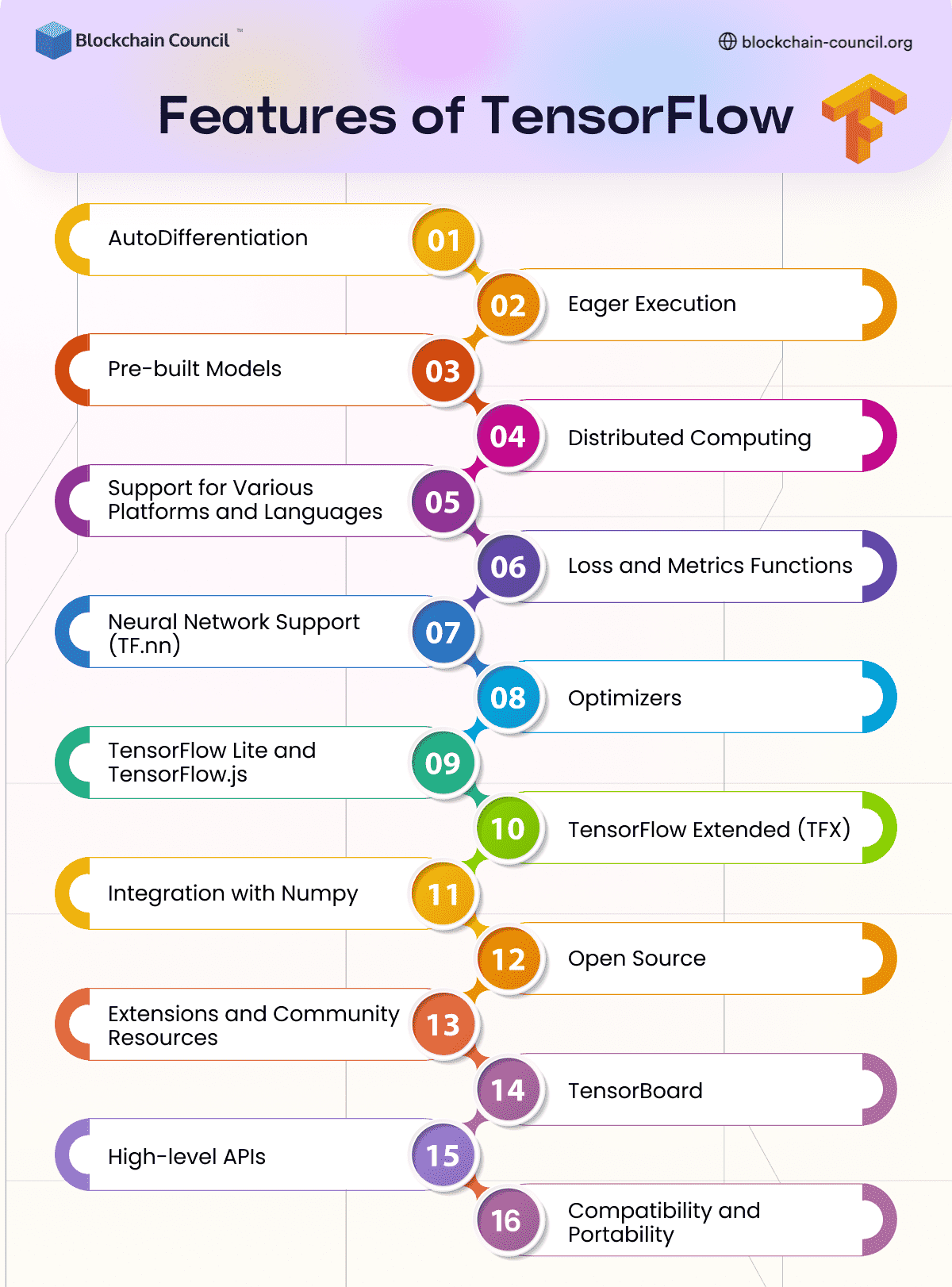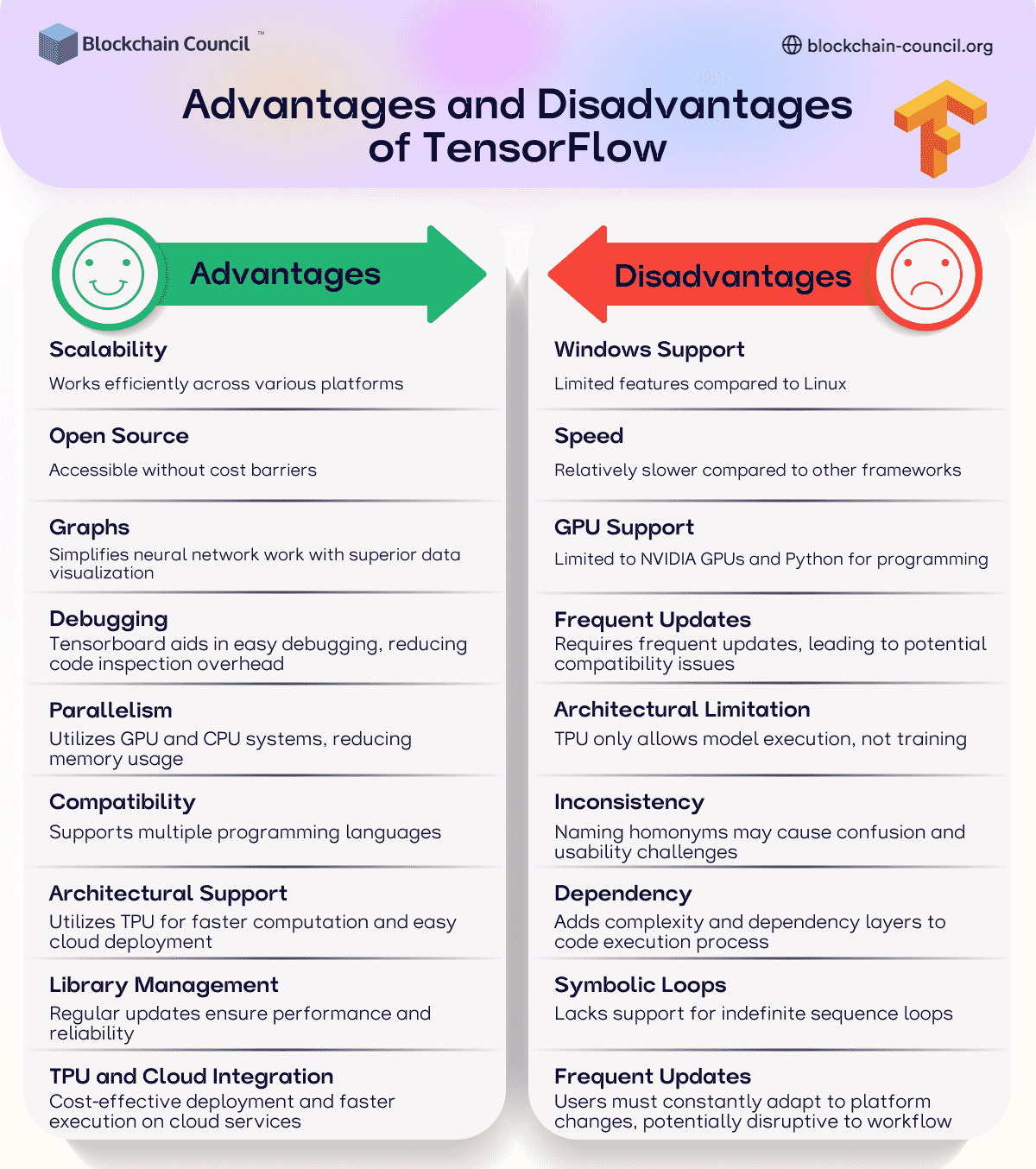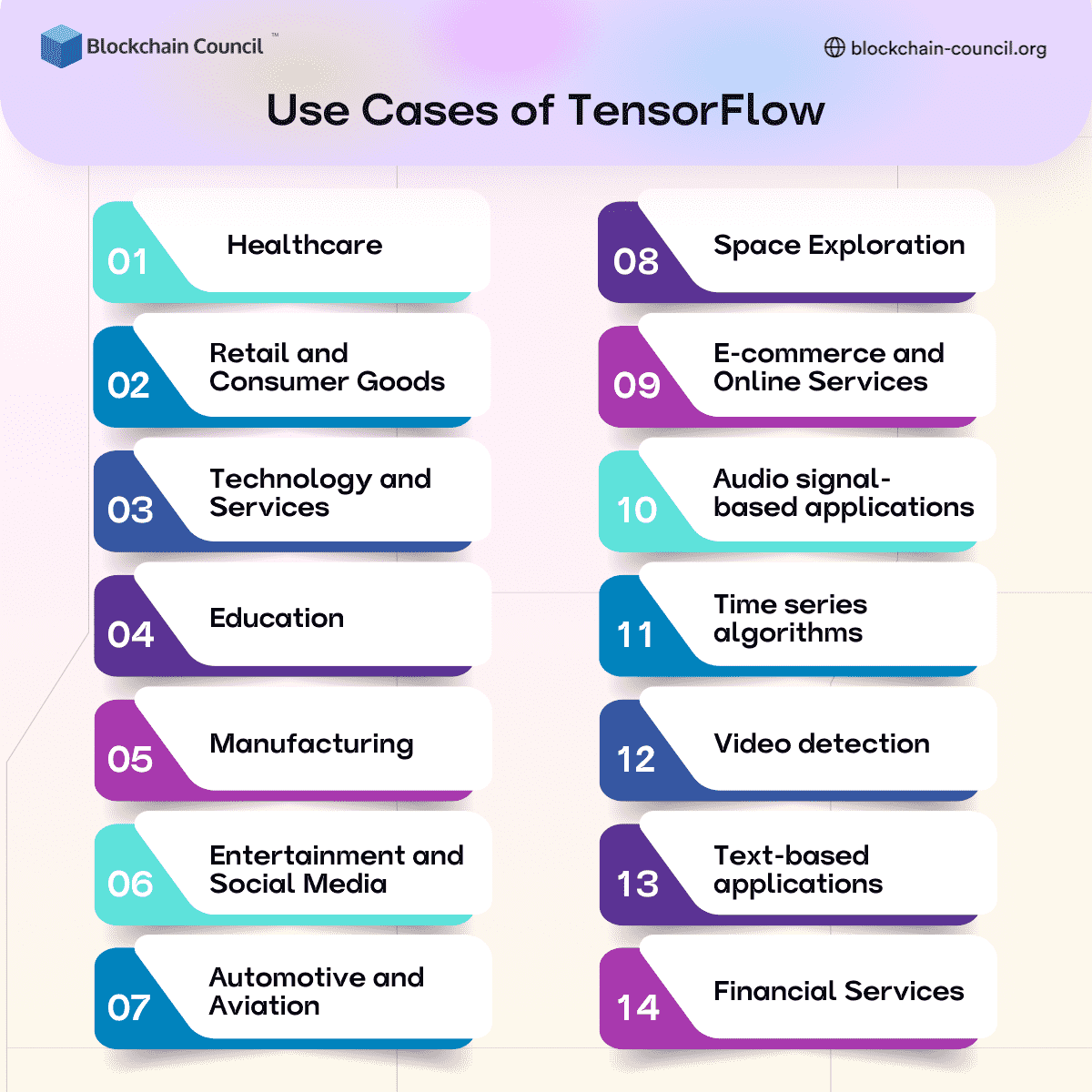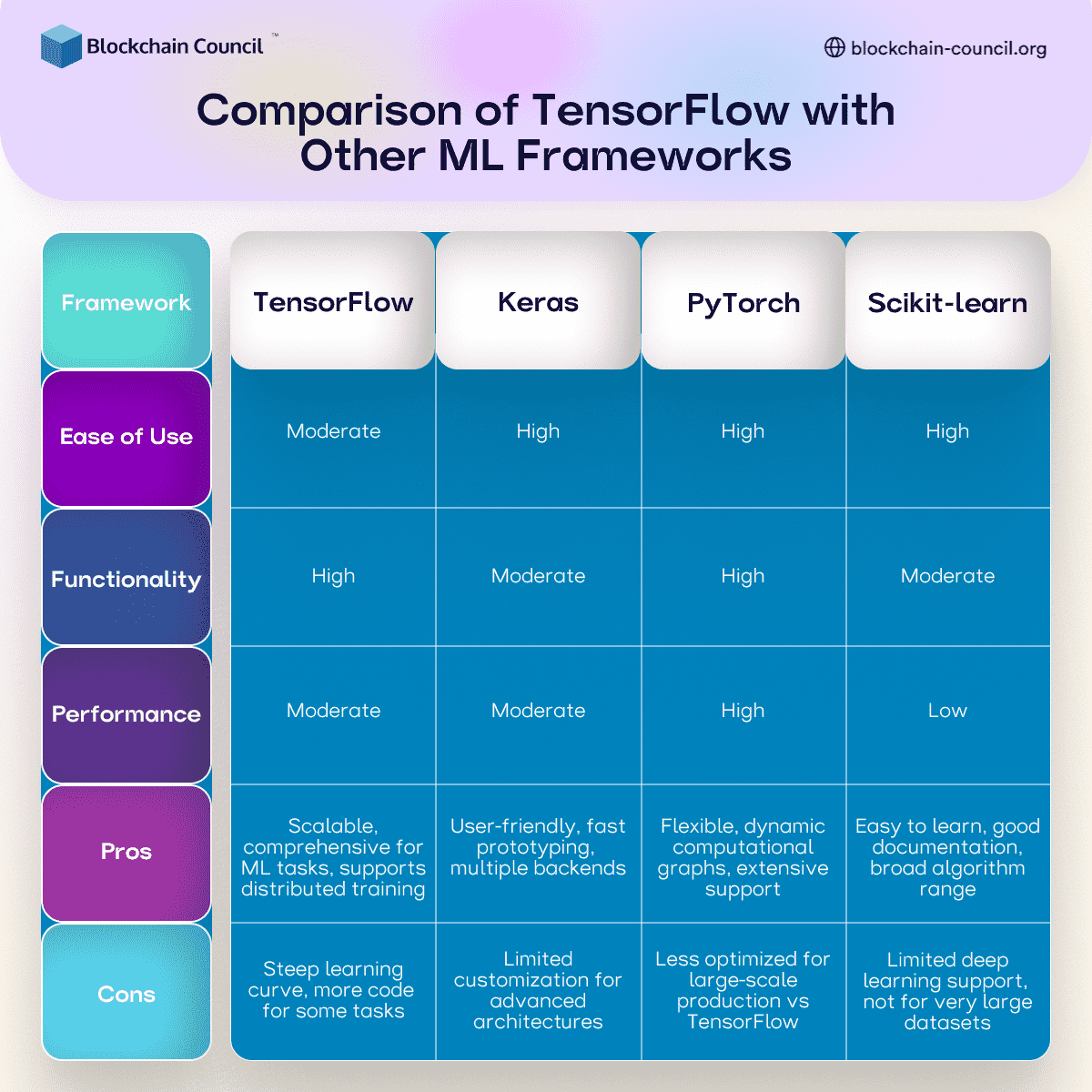
- Blockchain Council
- September 02, 2024
In a world that’s constantly changing, where technology evolves every day, staying ahead means being in the know. That’s where our focus on TensorFlow comes in. Today, TensorFlow isn’t just a buzzword. It’s the cornerstone of countless innovations and applications that touch every aspect of our lives. From making smartphones smarter to powering self-driving cars, TensorFlow’s impact is vast and growing.
Can you imagine the possibilities when tools like KerasCV for advanced image models and DTensor for scalable model training become more accessible and integrated into our development processes. We’re talking about a leap in efficiency and capability, where complex projects are not just possible but optimized for performance across various hardware setups.
And it doesn’t stop there. With TensorFlow’s ongoing evolution, such as the integration of JAX2TF, the gap between groundbreaking research and real-world applications narrows. It is unlocking new frontiers in AI and machine learning. But what exactly is TensorFlow and why is it so special? This article will answer all your burning questions regarding TensorFlow. We will discuss what TensorFlow is, how it works, what its core features are, and what makes it so special. So, let’s dive in!
What is TensorFlow and How Does it Work?
TensorFlow is a free of cost and open-source software library used for artificial intelligence and machine learning applications. It is widely used by data scientists, software developers, and educators for developing and deploying state-of-the-art machine learning models using data flow graphs. It was developed by GoogleBrain Team to enable developers and researchers to easily build and deploy ML-powered applications.
Within TensorFlow, the graph’s nodes symbolize mathematical operations, whereas the edges of the graph signify the multidimensional data arrays, also known as tensors, flowing between them. This adaptable structure permits machine learning algorithms to be articulated as a network of interconnected operations. It facilitates training and execution across diverse platforms without the need for code rewriting.
TensorFlow is designed for tasks like natural language processing, image recognition, handwriting recognition, and computational-based simulations. It supports both CPUs and GPUs, and even Google’s tensor processing units (TPUs) for accelerated performance. Let’s have a look at the key features of TensorFlow.
Core Features of TensorFlow
- AutoDifferentiation: TensorFlow automates the calculation of gradients, which are necessary for optimizing various machine learning algorithms. This feature is particularly useful for algorithms like backpropagation, which need gradients to improve model performance.
- Eager Execution: This mode allows TensorFlow operations to be executed immediately as they are called from Python, which makes it easier to debug programs and inspect operations.
- Pre-built Models: TensorFlow provides pre-built models for various tasks such as image classification, object detection, and natural language processing, facilitating quick model development.
- Distributed Computing: TensorFlow offers APIs to distribute computation across multiple devices (such as CPUs, GPUs, and TPUs), which can speed up the training and evaluation of models.
- Support for Various Platforms and Languages: TensorFlow is versatile, supporting various platforms and programming languages. This makes it accessible to a wide range of developers and applications.
- Loss and Metrics Functions: TensorFlow provides a variety of loss and metrics functions to evaluate the performance of models. This includes common ones like mean squared error for regression tasks and binary cross entropy for classification tasks.
- Neural Network Support (TF.nn): TensorFlow includes a module for executing fundamental neural network operations, supporting a wide range of functions like convolutions, activation functions, and pooling operations.
- Optimizers: A set of tools for optimizing neural networks, including popular algorithms like ADAM, ADAGRAD, and Stochastic Gradient Descent (SGD), to help with efficient model training.
- TensorFlow Lite and TensorFlow.js: These versions of TensorFlow are designed for mobile and web applications, allowing models to be deployed on a variety of platforms with efficient execution.
- TensorFlow Extended (TFX): This set of components supports end-to-end machine learning pipelines, covering everything from data preprocessing and model training to deployment.
- Integration with Numpy: TensorFlow works seamlessly with Numpy, a popular Python library for numerical computation, allowing for easy manipulation of data structures between the two.
- Open Source: Being open source, TensorFlow allows manipulation and innovation, fostering a DIY community with a vast forum for users.
- Extensions and Community Resources: TensorFlow supports a wide range of extensions that provide additional functionalities, including libraries for recommendation systems, graphics, and federated learning.
- TensorBoard: A tool for visually monitoring and analyzing TensorFlow programs, making it easier to understand the model’s structure and behavior.
- High-level APIs: TensorFlow offers high-level APIs like Keras and Estimators, simplifying the process of building and training machine learning models.
- Compatibility and Portability: TensorFlow models can be run on a wide range of devices and platforms, from desktops to mobile devices, and even in the cloud, with support for both CPUs and GPUs.
Advantages and Disadvantages of TensorFlow
TensorFlow 2.0: Definition and Key Updates
TensorFlow 2.0 is an updated version of TensorFlow that focuses on simple execution, ease of use, and developer productivity. It was released on September 30, 2019, and is designed to make the development of data science and machine learning applications easier. TensorFlow 2.0 includes features like tight integration of Keras, default Eager execution, and Pythonic function execution, making it more user-friendly and efficient for beginners and experts in the field of machine learning and deep neural networks.
Key Updates of TensorFlow 2.0
- Integration of Keras: TensorFlow 2.0 incorporates Keras as the primary high-level API, streamlining model creation, training, and validation.
- Model-building APIs: Offers various APIs (Sequential, Functional, and Subclassing) for building models, allowing users to select the appropriate level of abstraction.
- Default eager execution: TensorFlow 2.0 adopts eager execution by default, enhancing iteration speeds and simplifying debugging processes.
- Deployment improvements: Focuses on enhancing model deployment across different platforms, including servers, edge devices, web, and mobile platforms, by standardizing model exchange formats and aligning APIs.
- SavedModel format: Introduces the SavedModel format for easier sharing and deployment of models across TensorFlow’s ecosystem.
- Distribution Strategy API: Provides the Distribution Strategy API for efficient training across various hardware configurations with minimal code modifications.
- Performance enhancements: Offers substantial performance improvements on GPUs, with up to three times faster training performance on specific hardware configurations.
- Changes and unification: Removes redundant APIs, unifies RNNs and optimizers, and integrates Python’s runtime for a smoother development experience.
- Elimination of global namespaces and sessions: Moves towards a more Pythonic function execution model, eliminating the need for global namespaces and sessions.
- Focus on accessibility and efficiency: TensorFlow 2.0’s comprehensive improvements and new features aim to make machine learning more accessible and efficient for developers and researchers in the field.
Programming Languages and Platform Support
TensorFlow supports a wide range of programming languages and platforms, making it a versatile choice for developers and researchers in machine learning (ML) and artificial intelligence (AI). Here’s a brief overview of the languages and platforms TensorFlow is compatible with:
Programming Languages
- Python: This is the primary language supported by TensorFlow, offering a rich ecosystem of libraries and a straightforward syntax that’s easy to learn for beginners and powerful enough for experts.
- C++: TensorFlow provides APIs for C++, allowing developers to execute models with high performance, which is crucial for applications requiring fast computation.
- JavaScript: TensorFlow.js enables machine learning models to be trained and run directly in the browser, making ML more accessible to web developers and allowing for interactive web applications.
- Java: There is support for Java, particularly useful for developing Android applications that leverage machine learning.
- Swift and Objective-C: For iOS developers, TensorFlow provides support to integrate machine learning into mobile applications.
The primary language for TensorFlow is Python, which is the most complete and user-friendly API available. However, TensorFlow also provides APIs for other languages, including C++, Java, C#, Haskell, Julia, MATLAB, R, Ruby, Rust, Scala, and Perl. These APIs are not as fully developed as the Python API and are not yet covered by the API stability promises.
The C++ API is particularly notable because it is used for optimizing the interaction with GPUs, which is crucial in machine learning applications. TensorFlow offers a few APIs for C++ implementation, and the community is actively extending and porting the library to other programming languages.
Platforms and Libraries
- TensorFlow Lite: This version is optimized for mobile and embedded devices, such as smartphones, tablets, and IoT devices, enabling ML models to run efficiently on low-power hardware.
- TensorFlow.js: As mentioned, this allows running TensorFlow models directly in the browser or on Node.js, making it easier to deploy ML models in web applications.
- TFX (TensorFlow Extended): This is a Google-production-ready platform that provides tools and components to help deploy and manage ML models systematically.
TensorFlow also offers a variety of libraries and extensions to advance and extend the models and methods used, such as TensorFlow Recommenders, TensorFlow Graphics, TensorFlow Federated, and TensorFlow Cloud.
Real-world Applications and Use Cases of TensorFlow
Healthcare
TensorFlow has enabled significant advancements in healthcare. For instance, Google used it to enhance the accuracy of breast cancer diagnosis. GE Healthcare applied TensorFlow to train neural networks for identifying specific anatomy in brain MRIs, improving speed and reliability.
Retail and Consumer Goods
In the retail sector, TensorFlow helps companies like Coca-Cola to implement frictionless proof-of-purchase capabilities for loyalty programs.
Technology and Services
Google employs TensorFlow across its products such as Search, Gmail, and Translate to power various machine learning implementations. This fosters advancements in both humanitarian and environmental challenges.
Financial Services
In the financial domain, Kakao Mobility uses TensorFlow to predict ride-hailing request completion rates, enhancing the efficiency of their services.
Education
Liulishuo, an educational technology company, used TensorFlow to facilitate language learning, showcasing TensorFlow’s versatility in personalizing education.
Manufacturing
TensorFlow has applications in manufacturing too. It’s used to distinguish between fresh and rotten produce, aiding in quality control.
Entertainment and Social Media
InSpace utilizes TensorFlow.js for real-time toxicity filters in online chats, ensuring a safer online communication environment.
Automotive and Aviation
TensorFlow’s deep learning algorithms are pivotal in motion detection for automotive and aviation safety, role-based gaming, and security threat detection.
Space Exploration
NASA is employing TensorFlow algorithms for orbit classification and clustering of asteroids, enhancing our understanding and monitoring of near-earth objects.
E-commerce and Online Services
The framework is instrumental in text and image analysis, creation of intelligent chatbots, and natural language processing across platforms like social networks and e-commerce sites.
Audio signal-based applications
TensorFlow can be used to develop audio signal-based applications, such as voice recognition, voice search, sentiment analysis, flaw detection, and voice-activated assistants like Apple’s Siri, Google Now, and Microsoft Cortana.
Time series algorithms
TensorFlow is used for time series algorithms, which help analyze time series data and generate meaningful statistics. It can be used for stock market prediction, forecasting non-specific time periods, and generating alternative forecasts. Time series algorithms are commonly used in recommendation engines, such as those used by Netflix, Amazon, Facebook, and Google.
Video detection
TensorFlow’s deep learning algorithms can be used for video data, including motion detection in automotive and aviation, role-based gaming, security and threat detection, and video classification. Universities are doing deep research on video classification at a large scale, and NASA is using TensorFlow algorithms to build a system for orbit classification and object clustering of asteroids.
Text-based applications
TensorFlow is used for text-based applications, such as sentiment analysis, threat detection, fraud detection, language detection, and text summarization. Google Translate supports over 100 languages, and TensorFlow can be used for text summarization, such as producing headlines for news articles or generating email responses automatically.
Comparison of TensorFlow with Other ML Frameworks
Conclusion
As we wrap up our exploration of TensorFlow, it’s clear that we’re standing at the threshold of a new frontier in technology and artificial intelligence. TensorFlow has grown beyond its origins to become a key driver of innovation, empowering developers, researchers, and companies around the globe to push the boundaries of what’s possible.
With its latest updates and features, TensorFlow is not just enhancing the efficiency and capability of AI projects; it’s also making advanced machine learning more accessible and practical for real-world applications. For anyone keen on shaping the future of AI, staying updated with TensorFlow’s progress is not just beneficial—it’s essential.
Frequently Asked Questions
What is TensorFlow and who developed it?
- TensorFlow is a free and open-source software library for machine learning and artificial intelligence.
- It was developed by the Google Brain Team to enable developers and researchers to build and deploy ML-powered applications.
What are the key features of TensorFlow?
- TensorFlow operates through data flow graphs, where nodes represent mathematical operations and edges represent data flow between them.
- It offers features like auto differentiation, eager execution, pre-built models, and distributed computing.
- TensorFlow supports multiple platforms and programming languages, including Python, C++, JavaScript, Java, Swift, and Objective-C.
- The framework provides extensive support for various tasks such as natural language processing, image recognition, and computational-based simulations.
How does TensorFlow work?
- TensorFlow operates through data flow graphs, where nodes represent mathematical operations and edges represent the flow of data (tensors) between them.
- It allows developers to describe machine learning algorithms as a graph of connected operations, which can be trained and executed on various platforms without rewriting code.
- TensorFlow supports both CPUs and GPUs for computation, as well as Google’s tensor processing units (TPUs) for accelerated performance.
What are the advantages and disadvantages of TensorFlow?
- Advantages include scalability across platforms, open-source accessibility, simplified neural network work with graphs, and support for various programming languages.
- Disadvantages may include limited features on Windows compared to Linux, relatively slower speed compared to other frameworks, and potential compatibility issues due to frequent updates.
What are some real-world applications of TensorFlow?
- TensorFlow is extensively used in healthcare for tasks like enhancing the accuracy of breast cancer diagnosis and improving brain MRI analysis.
- In retail, TensorFlow facilitates frictionless proof-of-purchase capabilities for loyalty programs, as seen in companies like Coca-Cola.
- Google employs TensorFlow across its products like Search, Gmail, and Translate to power various machine learning implementations.
- Other sectors benefiting from TensorFlow include financial services, education, manufacturing, entertainment, automotive, aviation, space exploration, e-commerce, and audio and video analysis.









































































 Guides
Guides News
News Blockchain
Blockchain Cryptocurrency
& Digital Assets
Cryptocurrency
& Digital Assets Web3
Web3 Metaverse & NFTs
Metaverse & NFTs
